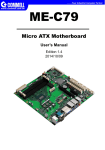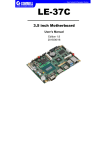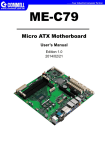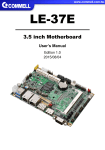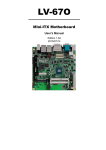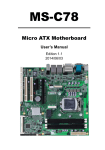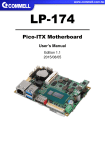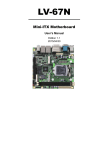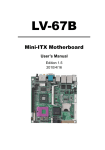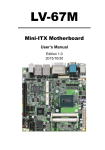Download LV-67M - Commell
Transcript
LV-67M Mini-ITX Motherboard User’s Manual Edition 1.6 2015/05/22 LV-67M User’s Manual Copyright Copyright 2013, all rights reserved. This document is copyrighted and all rights are reserved. The information in this document is subject to change without prior notice to make improvements to the products. This document contains proprietary information and protected by copyright. No part of this document may be reproduced, copied, or translated in any form or any means without prior written permission of the manufacturer. All trademarks and/or registered trademarks contains in this document are property of their respective owners. Disclaimer The company shall not be liable for any incidental or consequential damages resulting from the performance or use of this product. The company does not issue a warranty of any kind, express or implied, including without limitation implied warranties of merchantability or fitness for a particular purpose. The company has the right to revise the manual or include changes in the specifications of the product described within it at any time without notice and without obligation to notify any person of such revision or changes. Trademark All trademarks are the property of their respective holders. Any questions please visit our website at http://www.commell.com.tw TU UT -1- LV-67M User’s Manual Packing List: Please check the package content before you starting using the board. 1 x LV-67M Mini-ITX Motherboard (include Cooler Fan) 2 x SATA Cable (OALSATA3-L / 1040529) 1 x DC Power Cable (OALDC-A / 1040433) 1 x Power Cable (OALATX-P3S2 / 1040058) 1 x I/O Shield (OALATE-MCDLA / 1270055) Optional: USB3.0 Cable (OALUSB3 / 1040531) Dual COM PORT Cable (OALES-BKU2 / 1040087) USB2.0 Cable VGA Cable x 1 (OALUSBA-1 / 1040172) (OALVGAN-S / 1040568) -2- LV-67M User’s Manual Index Chapter 1 <Introduction>............................................................... 4 1.1 <Product Overview>................................................................................. 4 1.2 <Product Specification> ........................................................................... 5 1.3 <Mechanical Drawing>............................................................................. 6 1.4 <Block Diagram>...................................................................................... 7 Chapter 2 <Hardware setup>......................................................... 8 2.1 <Connector Location and Reference> ..................................................... 8 2.1.1 <Internal connectors list> ............................................................. 9 2.1.2 <External connectors list> ............................................................ 9 2.2 <Jumper Location and Reference>........................................................ 10 2.2.1 <Jumper list> .............................................................................. 10 2.3 <Installing the Memory>......................................................................... 11 2.4 <Clear CMOS and Power on type selection> ........................................ 12 2.5 <I/O interface>........................................................................................ 13 2.5.1 <Serial ATA interface> ................................................................ 13 2.5.2 <Ethernet interface> ................................................................... 15 2.5.3 <Display interface>..................................................................... 15 2.5.4 <Audio interface> ....................................................................... 18 2.5.5 <USB interface> ......................................................................... 19 2.5.6 <Serial Port interface>................................................................ 21 2.5.7 <Expansion slot> ........................................................................ 24 2.5.8 <Front panel switch and indicator> ............................................ 25 2.5.9 <GPIO and Other interface> ...................................................... 26 2.6 <Power supply>...................................................................................... 28 2.6.1 <Power input> ............................................................................ 28 2.6.1 <Power output> .......................................................................... 29 Appendix A <Flash BIOS> ........................................................... 30 Appendix B <Programmable GPIO > .......................................... 31 Appendix C <Programmable Watch Dog Timer>....................... 32 Contact information ..................................................................... 33 -3- LV-67M User’s Manual Chapter 1 <Introduction> 1.1 <Product Overview> LV-67M is Mini-ITX Motherboard which supports 4th Generation Intel® Core™ i7, i5, i3, Celeron Mobile Processor and features Intel DH82QM87 chipset, integrated HD Graphics, DDR3L memory, Realtek High Definition Audio, Intel Gigabit LAN, Serial ATA with AHCI and RAID function for a system. Intel Haswell Processor The 4th Generation Intel® Core™ mobile processor family is the next generation of 64-bit, multi-core mobile processor built on 22- nanometer process technology. Based on a new micro-architecture. Intel Lynx Point chipset The DH82QM87 chipset provides better CPU, graphics, media performance, flexibility and more enhanced security that is suitable for a variety of intelligent systems the ideal choice. All in One multimedia solution Based on Intel DH82QM87 chipset, the board provides high performance onboard graphics, 24-bit dual channel LVDS interface, DisplayPort, DVI-I, and High Definition Audio, to meet the very requirement of the multimedia application. Flexible Expansion Interface The board provides one PCIe X16 slot, two Mini PCIe slot with one SIM slot. -4- LV-67M User’s Manual 1.2 <Product Specification> System Processor Chipset Memory Watchdog Timer Real Time Clock Expansion 4th Gen Intel® Core™ i7, i5, i3, Celeron Mobile Processor FCBGA1364 package Intel® DH82QM87 PCH 2 x DDR3L SO-DIMM 1333/1600 MHz up to 16GB Support Non-ECC, unbuffered memory only Generates a system reset with internal timer for 1min/s ~ 255min/s Chipset integrated RTC with onboard lithium battery 1 x PCIe x16, 2 x Mini PCIe (one support mSATA), 1 x SIM slot Note that mSATA Only Support SATA3 Graphics Chipset Display Interface Intel® 4th Gen integrated HD Graphics 1 x VGA, 1 x DVI-I, 1 x DisplayPort, 1 x LVDS LAN Chip 1 x Intel® I210-AT Gigabit LAN 1 x Intel® I217-LM Gigabit LAN (Support iAMT9.0) I/O Serial ATA Audio Digital I/O Internal I/O Rear I/O 4 x SATA3 support RAID0, 1, 5, 10 and IRST Note that Hard Disk Only Support SATA3 Realtek ALC888 HD Audio Programmable 8-bit GPIO with 12 pin-header 4 x SATA3, 4 x RS232, 4 x USB2.0, 2 x USB3.0, 1 x VGA, 1 x LVDS, 1 x LCD inverter, 1 x LPC, 1 x SMBUS, 1 x DIO, 1 x Front panel Audio, 1 x CDIN, 1 x IrDA 1 x PS/2, 1 x RS232/422/485, 1 x RS232, 1 x DVI-I, 1 x DisplayPort, 4 x USB3.0, 2 x LAN, 1 x Audio Mechanical & Environmental Power Requirement Size & Thickness Temperature Relative Humidity ATX or DC Input 9~24V Note that do not use at the same time 170mm x 170mm (L x W), 1.6mm Operating within 0°C~60°C (32°F~140°F) Storage within -20°C~80°C (-4°F~176°F) 10%~90%, non-condensing -5- LV-67M User’s Manual 1.3 <Mechanical Drawing> -6- LV-67M User’s Manual 1.4 <Block Diagram> eDP PCIe x16 PTN3460 CPU 1 x LVDS DDI Channel A DDR3L SO-DIMM Channel B DDR3L SO-DIMM 4th Gen Processor 1 x DisplayPort DDI 1 x DVI-I FDI DMI VGA PCIe x1 1 x VGA I210-AT SATA3 PCIe x1 4 x SATA3 I217-LM USB3.0 PCH 6 x USB3.0 PCIe x1 MiniPCIe1 SATA3 USB2.0 / mSATA QM87 4 x USB2.0 PCIe x1 Mini PCIe2 SPI SPI Flash HDA ALC888 HD Audio LPC F81216D 4 x RS232 1 x LPC 1 x RS232 1 x RS232/422/485 1 x SMBUS SIO 1 x IrDA W83627DHG-P 1 x DIO 1 x CDIN 1 x PS/2 -7- LV-67M User’s Manual Chapter 2 <Hardware setup> 2.1 <Connector Location and Reference> CN_CRT CD_IN CN_LVDS CN_INV CN_AUDIO CN_LPC CN_DIO DC_IN SIMM CN_SMBUS MINI_CARD2 CPUFAN CN_IR PCIe x16 MINI_CARD1 CN_COM5/6 CN_COM3/4 ATX CN_USB3 JFRNT SATA3-1 SATA3-2 SATA3-3 SATA3-4 SYSFAN PS/2 COM2 COM1 CN_USB2-1 CN_USB2-2 SO-DIMM2 DVI DisplayPort -8- RJ45_2 USB3.0 SO-DIMM1 RJ45_1 USB3.0 Audio LV-67M User’s Manual 2.1.1 <Internal connectors list> Connector Function SO-DIMM1/2 204-pin DDR3 SO-DIMM slot SATA3-1/2/3/4 7-pin Serial ATA3 connector CN_AUDIO 5 x 2-pin audio pin header CN_DIO 6 x 2-pin GPIO pin header CN_LPC 6 x 2-pin LPC pin header CN_CRT 8 x 2-pin CRT pin header CN_LVDS 20 x 2-pin LVDS connector CN_INV 5 x 1-pin LCD inverter pin header CN_SMBUS 5 x 1-pin SMBUS pin header CN_IR 5 x 1-pin IR pin header CN_COM3/4 10 x 2-pin RS232 pin header CN_COM5/6 10 x 2-pin RS232 pin header CN_USB2-1/2 5 x 2-pin USB2.0 pin header CN_USB3 10 x 2-pin USB3.0 pin header CD_IN 5 x 1-pin CD-ROM audio input pin header CPUFAN 4-pin CPU smart fan connector SYSFAN 3-pin system fan connector JFRNT 7 x 2-pin front panel switch/indicator pin header MINI_CARD1/2 52-pin mini PCIe card slot SIMM 6-pin SIM card slot PCIe x16 164-pin support PCIe x16 slot DC_IN ATX12V connector support DC 9~24V input ATX 20+4-pin main power connector 2.1.2 <External connectors list> Connector Function PS/2 PS/2 female connector for keyboard and mouse COM1/2 DB9 male connector DVI DVI-I dual link connector DisplayPort DisplayPort connector USB_RJ45_1/2 2 x USB3.0 and 1 x RJ45 connector AUDIO Audio jack support Line-in, Line-out, Mic-in -9- LV-67M User’s Manual 2.2 <Jumper Location and Reference> JP2 JCSEL1 JP1 JCSEL2 JVLCD JAT JMSATA JRTC JP3 JP4 JVUSB 2.2.1 <Jumper list> Jumper Function JAT Power mode select JRTC CMOS Normal/Clear Setting JVUSB USB 5V/5VSB Setting JVLCD Panel Voltage Setting JMSATA MiniCard1 mSATA Setting JCSEL1 COM2 RS-232, RS422, RS485 setting or IrDA setting JCSEL2 COM2 RS-232, RS422, RS485 setting or IrDA setting JP1 Com1 Voltage Setting (For Pin 9) JP2 Com2 Voltage Setting (For Pin 9) JP3 Com3 Voltage Setting (For Pin 9) JP4 Com4 Voltage Setting (For Pin 9) -10- LV-67M User’s Manual 2.3 <Installing the Memory> In the process, the board must be powered off. 1. Put the memory tilt into the slot. Note the Memory notch key aligned slot key. 2. Then press down till lock into the mounting notch. Key Press down Mounting notch 3. To remove the memory, push outward on both sides of the latch. Latch -11- LV-67M User’s Manual 2.4 <Clear CMOS and Power on type selection> JRTC: Clear CMOS data jumper Jumper settings 1-2 2-3 Function Clear CMOS Normal (Default) JAT: AT/ATX mode select jumper Jumper settings 1-2 2-3 Function AT mode ATX mode (Default) JAT 1 3 JRTC 1 3 -12- LV-67M User’s Manual 2.5 <I/O interface> 2.5.1 <Serial ATA interface> SATA3-1/2/3/4: SATA 7-pin connector Pin 1 2 3 4 5 6 7 Signal GND TX+ TXGND RXRX+ GND Support RAID0, 1, 5, 10. SATA3-1 SATA3-2 SATA3-3 SATA3-4 When use RAID function, it need to enter the BIOS set RAID mode first. [Advanced] > [HDD Configuration] > [Interface Combination] > [RAID] -13- LV-67M User’s Manual At boot time, press <CTRL + I> to enter the RAID configuration menu. If this screen stop time is too short, it can be set in the BIOS. [HDD Configuration] > [Software Feature Mask Configuration] > [OROM UI Normal Delay] (Need to set RAID mode first) -14- LV-67M User’s Manual 2.5.2 <Ethernet interface> The board Integrated I210-AT and I217-LM Gigabit Ethernet which supports WOL on rear I/O. The I217-LM support Intel® AMT 9.0 feature, if want to use, need to enable in the BIOS. (Note that your CPU must support vPro technology, ex: i7-4700EQ) I217-LM I210-AT 2.5.3 <Display interface> Based on the 4th Gen CPU with built-in HD Graphics, the DVI-I resolution up to 1920x1200 @ 60Hz and DisplayPort up to 3840x2160 @ 60Hz on rear I/O. About the internal Display, the VGA resolution up to 1920x1200 @ 60Hz and LVDS (PTN3460) up to 1920x1200 @ 60Hz support 24-bit color depth and dual channel. The built-in HD Graphics support triple display function with clone mode and extended mode. DVI-I DisplayPort -15- LV-67M User’s Manual CN_CRT 2 16 1 15 CN_LVDS 1 39 2 40 JVLCD 1 2 CN_INV 5 6 1 5 CN_CRT: VGA 16-pin header (Pitch 2.00mm) Pin 1 3 5 7 9 11 13 15 Signal RED BLUE DETECT GND Key Key HSYNC SCL Pin 2 4 6 8 10 12 14 16 Note that pin 5, 10 active low. -16- Signal GREEN Key GND GND DETECT SDA VSYNC NC LV-67M User’s Manual CN_LVDS: LVDS 40-pin connector (Model: HIROSE DF13-40DP-1.25V compatible) Pin 2 4 6 8 10 12 14 16 18 20 22 24 26 28 30 32 34 36 38 40 Signal Set by JVLCD GND A_LVDS_0A_LVDS_0+ GND A_LVDS_1A_LVDS_1+ GND A_LVDS_2A_LVDS_2+ GND A_LVDS_CLKA_LVDS_CLK+ GND A_LVDS_3A_LVDS_3+ GND LVDS_DDCSCL LVDS_DDCSDA NC Pin 1 3 5 7 9 11 13 15 17 19 21 23 25 27 29 31 33 35 37 39 CN_INV: LVDS 5-pin Backlight power header Pin 1 2 3 4 5 Signal 12V Backlight Control GND GND Enable Backlight JVLCD: LVDS panel power select jumper Jumper settings 1-2 3-4 5-6 Function 3.3V (Default) 5V 12V Effective patterns of connection: 1-2 / 3-4 / 5-6 Other may cause damage -17- Signal Set by JVLCD GND B_LVDS_0B_LVDS_0+ GND B_LVDS_1B_LVDS_1+ GND B_LVDS_2B_LVDS_2+ GND B_LVDS_3B_LVDS_3+ GND B_LVDS_CLKB_LVDS_CLK+ GND NC NC NC LV-67M User’s Manual 2.5.4 <Audio interface> CDIN 1 4 CN_AUDIO 2 10 1 9 Rear Audio Jack Line in Line out Mic in CDIN: CD-ROM audio input 4-pin header (Pitch 2.54mm) Pin 1 2 3 4 Signal CD_L GND GND CD_R CN_AUDIO: Front panel audio 10-pin header (Pitch 2.54mm) Pin 1 3 5 7 9 Signal MIC_L MIC_R FP_OUT_R SENSE FP_OUT_L Pin 2 4 6 8 10 -18- Signal GND NC MIC_DETECT Key FP_OUT_DETECT LV-67M User’s Manual 2.5.5 <USB interface> USB3.0-2 Type: 5V/5VSB USB3.0-1 Type: 5VSB JVUSB 1 2 5 6 CN_USB3 20 CN_USB2-1/2 1 1 2 9 10 Type: USB2.0, 5VSB 11 10 Type: USB3.0, 5V/5VSB -19- LV-67M User’s Manual CN_USB3: Front panel USB3.0 20-pin header (Pitch 2.00mm) Pin 20 19 18 17 16 15 14 13 12 11 Signal Key Set by JVUSB SSRX1SSRX1+ GND SSTX1SSTX1+ GND DATA1DATA1+ Pin 1 2 3 4 5 6 7 8 9 10 Signal Set by JVUSB SSRX0SSRX0+ GND SSTX0SSTX0+ GND DATA0DATA0+ NC CN_USB2-1/2: Front panel USB2.0 10-pin header (Pitch 2.54mm) Pin 1 3 5 7 9 Signal VCC (5VSB) DATA0DATA0+ GND GND Pin 2 4 6 8 10 Signal VCC (5VSB) DATA1DATA1+ GND Key JVUSB:USB power type select jumper (Only for USB3.0-2 & CN_USB3) Jumper settings 1-3 &2-4 3-5 & 4-6 Function 5VSB (Default) 5V Effective patterns of connection: 1-3 & 2-4 / 3-5 & 4-6 Other may cause damage -20- LV-67M User’s Manual 2.5.6 <Serial Port interface> COM1 COM2 Type: RS232/422/485 JP2 JP1 2 2 2 19 20 2 19 20 1 11 5 JCSEL2 COM3/4 1 12 5 COM5/6 1 2 6 1 1 JCSEL1 6 JP3 JP4 2 6 2 6 1 5 1 5 -21- 2 8 1 7 LV-67M User’s Manual COM1: RS232 DB9 connector Pin 1 3 5 7 9 Signal DCD TXD GND RTS Set by JP1 Pin 2 4 6 8 Signal RXD DTR DSR CTS Pin 2 4 6 8 Signal RXD/ 422TX+/ 485+ DTR/ 422RXDSR CTS COM2: RS232/422/485 DB9 connector Pin 1 3 5 7 9 Signal DCD/ 422TX-/ 485TXD/ 422RX+ GND RTS Set by JP2 Use JCSEL1 and JCSEL2 to select communication mode COM3/4: COM 20-pin header (Pitch 2.54 x 1.27mm) Pin 1 3 5 7 9 11 13 15 17 19 Signal DCD1 TXD1 GND RTS1 COM3 Set by JP3 DCD2 TXD2 GND RTS2 COM4 Set by JP4 Pin 2 4 6 8 10 12 14 16 18 20 -22- Signal RXD1 DTR1 DSR1 CTS1 NC RXD2 DTR2 DSR2 CTS2 Key LV-67M User’s Manual COM5/6: COM 20-pin header (Pitch 2.54 x 1.27mm) Pin 1 3 5 7 9 11 13 15 17 19 Signal DCD1 TXD1 GND RTS1 RI1 DCD2 TXD2 GND RTS2 RI2 Pin 2 4 6 8 10 12 14 16 18 20 Signal RXD1 DTR1 DSR1 CTS1 NC RXD2 DTR2 DSR2 CTS2 Key JP1, JP2, JP3, JP4: COM1, COM2, COM3, COM4 pin-9 setting Jumper settings 1-2 3-4 5-6 Function 5V 12V RI (Default) Effective patterns of connection: 1-2 / 3-4 / 5-6 Other may cause damage JCSEL1, JCSEL2: For configure COM2 communication mode Function JCSEL1 JCSEL2 2 12 2 8 1 11 1 7 2 12 2 8 1 11 1 7 2 12 2 8 1 11 1 7 2 12 2 8 1 11 1 7 RS232 RS485 RS422 IrDA -23- LV-67M User’s Manual 2.5.7 <Expansion slot> MINI_CARD2 SIMM PCIe x16 MINI_CARD1 JMSATA MINI_CARD1 and MINI_CARD2 have do some special design to compatible our mini-PCIe card. (ex: MPX-574D2, MPX-210D2 etc) MINI_CARD1 support mSATA set by JMSATA, and MINI_CARD2 support SIM card to use 3G module. JMSATA: Setting MINI_CARD1 to support PCIe/mSATA Jumper settings 1-2 2-3 Function Support mSATA Normal operation (Default) -24- LV-67M User’s Manual 2.5.8 <Front panel switch and indicator> JFRNT 1 2 13 14 JFRNT: Front panel switch and indicator 14-pin header (Pitch 2.54mm) Pin 1 3 5 7 9 11 13 Signal HDD_LED+ HDD_LEDReset+ ResetKey Power_ON+ Power_ON- Pin 2 4 6 8 10 12 14 -25- Signal Power_LED+ NC Power_LEDSpeaker+ NC NC Speaker- LV-67M User’s Manual 2.5.9 <GPIO and Other interface> 12 2 CN_LPC CPUFAN 1 2 12 1 11 11 1 CN_DIO CN_SMBUS CN_IR 1 1 5 5 SYSFAN 1 3 When using GPIO function, please note: As Output: Open-drain, most applications need use an external pull up resistor. (If not may cause damage) As Input: TTL-level. GPIO DC characteristics Parameter Input Low Voltage Input High Voltage Output Low Voltage Input High Leakage Input Low Leakage SYM VIL VIH VOL ILIH ILIL MIN TYP MAX 0.8 2.0 0.4 +10 -10 UNIT V V V μA μA Conditions IOL =12mA VIN =3.3V VIN =0V CN_DIO: GPIO 12-pin header (Pitch 2.00mm) Pin 1 3 5 7 9 11 Signal GND GPIO0 GPIO1 GPIO2 GPIO3 5V Pin 2 4 6 8 10 12 -26- Signal GND GPIO4 GPIO5 GPIO6 GPIO7 12V 4 LV-67M User’s Manual CN_LPC: LPC 12-pin header (Pitch 2.00mm) Pin 1 3 5 7 9 11 Signal CLK -LFRAME LAD2 LAD0 SERIRQ 3.3VSB Pin 2 4 6 8 10 12 CN_LPC support TPM module. CN_SMBUS: SMBus 5-pin header (Pitch 2.54mm) Pin 1 2 3 4 5 Signal VCC (5V) Key SMBDAT SMBCLK GND CN_IR: IrDA 5-pin header (Pitch 2.54mm) Pin 1 2 3 4 5 Signal VCC (5V) Key IRRX IRDX GND CPUFAN: CPU cooler Smart fan 4-pin header Pin Signal 1 GND 2 12V 3 Sensor SYSFAN: System cooler fan 3-pin header Pin Signal 1 GND 2 12V 3 Sensor -27- 4 Control Signal RST LAD3 LAD1 3.3V GND NC LV-67M User’s Manual 2.6 <Power supply> 2.6.1 <Power input> DC_IN 1 2 ATX 3 4 12 24 1 13 The DC_IN support 9~24V wide voltage input. Note that the DC_IN and ATX do not use at the same time, it will certainly cause damage. DC_IN: ATX12V 4-pin connector Pin 1 3 Signal GND 9~24V Pin 2 4 Signal GND 9~24V ATX: main power 24-pin connector (As input) Pin 1 2 3 4 5 6 7 8 9 10 11 12 Signal 3.3V 3.3V GND 5V GND 5V GND Power_OK 5VSB 12V 12V 3.3V Pin 13 14 15 16 17 18 19 20 21 22 23 24 -28- Signal 3.3V -12V GND -PSON GND GND GND -5V 5V 5V 5V GND LV-67M User’s Manual 2.6.1 <Power output> It is supply to the HDD, CD-ROM or other device. If using DC_IN as input, that ATX will as output. ATX: main power 24-pin connector (As output) Pin 1 2 3 4 5 6 7 8 9 10 11 12 Signal 3.3V 3.3V GND 5V GND 5V GND Pin 13 14 15 16 17 18 19 20 21 22 23 24 12V 12V 3.3V Note that Maximum output power: 12V/2A, 5V/3A, 3.3V/3A -29- Signal 3.3V GND GND GND GND 5V 5V 5V GND LV-67M User’s Manual Appendix A <Flash BIOS> A.1 <Flash tool> The board is based on Phoenix BIOS and can be updated easily by the BIOS auto flash tool. You can download the tool online at the address below: http://www.commell.com.tw/Download/BIOS/FPT9.rar The tool’s file name is “fpt.exe”, it’s the utility that can write the data into the BIOS flash chip and update the BIOS. A.2 <Flash BIOS process> 1. Please make a bootable UFD which can boot into DOS enviroment. 2. Unzip the flash tool and copy it into bootable UFD. 3. Add a bin file to the same folder.. 4. Power on the system and flash the BIOS under the DOS environment. (Command: fpt –savemac –f xxx.bin) 5. Restart the system. -30- LV-67M User’s Manual Appendix B <Programmable GPIO > The GPIO’ can be programmed with the MS-DOS debug program using simple IN/OUT commands. The DC characteristics please refer to GPIO paragraph (Page25). GPIO Bit -o 2E 87 0 0 1 1 2 2 3 3 4 4 5 5 6 6 7 7 ;enter configuration -o 2E 87 -o 2E 07 -o 2F 09 ;select Logical Device -o 2E 30 -o 2F 02 ;activate GPIO function (The board use GPIO3) -o 2E F0 -o 2F XX ;set “01” GPIO as input, set “00” GPIO as output -o 2E F1 -o 2F XX ;if set GPIO as output, this register’s value can be set “00~ FF” Optional -o 2E F2 -o 2F XX ;set “01”, the respective bit are inverted (Both input and output) ;set “00”, the respective bit are normal For further information, please refer to Winbond W83627DHG-P datasheet. -31- LV-67M User’s Manual Appendix C <Programmable Watch Dog Timer> Timeout value range 1 to 255 Minute and Second Program sample Watchdog timer setup as system reset with 5 second of timeout -o 2E 87 ;enter configuration -o 2E 87 -o 2E 07 -o 2F 08 ;select Logical Device -o 2E 30 -o 2F 01 ; activate WDTO# function -o 2E F5 -o 2F 00 ;set “00” is second mode, set “04” is minute mode -o 2E F6 -o 2F 05 ;00h: Timeout Disable ;01h: Timeout occurs after 1 minute only ;02h: Timeout occurs after 2 second/minute ;03h: Timeout occurs after 3 second/minute … ;FFh: Timeout occurs after 255 second/minute (The deviation is approx 1 second.) For further information, please refer to Winbond W83627DHG-P datasheet -32- LV-67M User’s Manual Contact information Any advice or comment about our products and service, or anything we can help you please don’t hesitate to contact with us. We will do our best to support you for your products, projects and business. Taiwan Commate computer Inc. 19F., NO.94, Sec. 1, Xintai 5th Rd., Xizhi Dist., New Taipei City Address 22102, Taiwan. TEL +886-2-26963909 FAX +886-2-26963911 Website www.commell.com.tw [email protected] (General infomation) E-mail [email protected] (Technical Support) Facebook https://www.facebook.com/pages/Taiwan-Commate-Computer-Inc/547993955271899 Twitter https://twitter.com/Taiwan_Commate Commell is a brand name of Taiwan Commate computer Inc. -33-


































